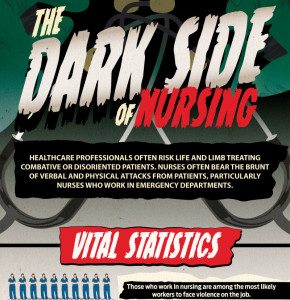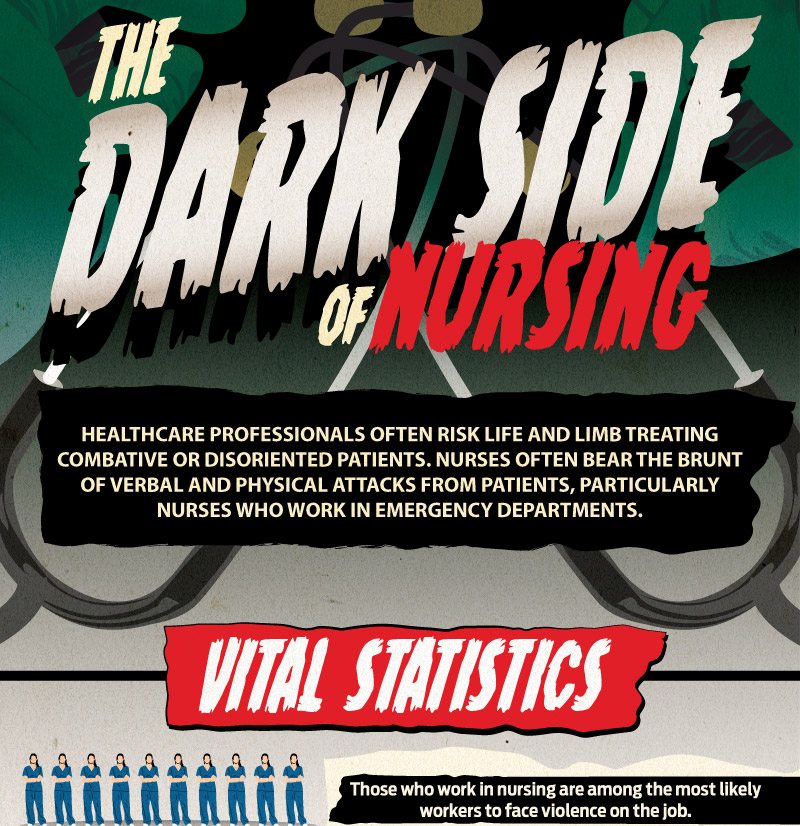Infographic – Nursing’s Dark Side
The dark side of nursing shows the risk nurses face when treating combative or disoriented patients, including verbal and physical attacks.

Nursing Dark Side Vital Statistics
Healthcare professionals often risk life and limb treating combative or disoriented patients. Nurses often bear the brunt of verbal and physical attacks from patients, particularly nurses who work in emergency departments.
3 million
Registered nurses in the U.S.
Those who work in nursing are among the most likely workers to face violence on the job.
62%
Registered nurses who work in hospital settings
Violence can occur anywhere in a hospital, but it’s most common in:
- Psychiatric wards
- Emergency rooms
- Waiting rooms
- Geriatric units
Emergency nurses often face some of the most belligerent and incoherent patients.
More than 1 in 2
ER nurses who reported being regular targets of verbal abuse
54.5%
ER nurses who say they’ve experienced physical violence and/or verbal abuse
0.8%
ER nurses who reported physical violence only
What Happens
Emergency nurses often come face-to-face with patients who are mentally ill, intoxicated or otherwise violent. As a result, a great many of these nurses report facing serious physical violence and intimidating verbal abuse.
Among ER nurses who report experiencing physical violence …
Bitten 6.4%
Choked 0.4%
Grabbed/pulled 48.3%
Hair pulled 1.8%
Punched/slapped 41.3%
Struck by thrown object 16.6%
Kicked 25.8%
Pinched 16.3%
Pushed/shoved/thrown 27.6%
Scratched 20%
Sexually assaulted 0.5%
Spit on 35.8%
Stabbed 0.3%
Voided/vomited on purposefully 5.8%
Among nurses who reported being targets of verbal abuse
Called names 68.2%
Harassed with sexual language/innuendos 22.7%
Threatened with legal action 51.8%
Threatened with physical violence/weapons 19.8%
Sworn/cursed at 89%
Yelled/shouted at 89%
Patients were the perpetrators in 97.8% of physical violence incidents and 92.3% of verbal abuse cases.
Preventive Care – Safety Tips for Hospital Workers
Signs of impending violence:
- Verbally expressed anger and frustration
- Body language such as threatening gestures
- Signs of drug or alcohol use
- Presence of a weapon
Control your behavior
- Present a calm, caring attitude.
- Don’t match the threats.
- Don’t give orders.
- Acknowledge the person’s feelings.
- Avoid any behavior that may be interpreted as aggressive (moving rapidly, getting too close, touching or speaking loudly).
Remain alert
- Evaluate each situation for potential violence when you enter a room or begin to relate to a patient or visitor.
- Don’t isolate yourself with a potentially violent person.
- Always keep an open path for exiting; don’t let the potentially violent person stand between you and the door.
Act quickly
- Remove yourself from the situation if necessary.
- Call security for help.
- Report any violent incidents to your management.
Hospitals should provide
- Locked entries
- An enclosed nurses’ station
- Call code pseudonyms
- Security signs
- Well-lit areas.
- In-room panic buttons.

Related:






